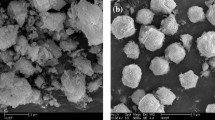Abstract
The adsorption equilibrium of water on microporous adsorbents (zeolites of NaA-, NaY- and NaX-type as well as their ion exchanged forms) and on mesoporous adsorbents (different silica gels and composite material i.e. silica gel + salt hydrate) has been studied experimentally and theoretically. Using the Dubinin theory of pore filling the characteristic curves of the adsorption systems and other relevant dependences such as isotherms, isobars, isosteres and the curve of the differential heat of adsorption were calculated. For all systems investigated the adsorption were calculated. Aads and the desorption potential Ades of the closed heat storage system were estimated. These values define the working range of the adsorption/desorption cycle and allow to calculate the specific heat storage density Δ hsp. On the basis of Δ hsp the different adsorbents were compared in order to select the optimal porous storage material for a given application.
The presented experimental and theoretical investigations show that the adsorption systems water-zeolite and water-composites are promising working pairs for thermochemical heat storage processes for hot tap water supply and space heating of single family dwellings. The advantage of the water-composite system is the low desorption temperature (solar energy) the main shortcoming the low temperature lift. The advantage of the water zeolite system is the high temperature lift, the shortcoming are the relative high desorption temperatures.
Similar content being viewed by others
References
Aristov, Y.I., et al.,”Selective Water Sorbents for Multiple Applications. 1. Ca Cl2 Confined in Mesopores of Silica Gel: Sorption Properties,” React. Kinet. Cat. Letters, 59, 325–333 (1996).
Aristov, Y.I., et al., “Selctive Water Sorbents for Multiple Applications. 1. Ca Cl2 Confined in Micropores of Silica Gel: Sorption Properties,” React. Kinet. Cat. Letters, 59 (1996) 335–342.
Dubinin, M.M., “Theory of Physical Adsorption of Gases and Vapors and Adsorption Properties of Adsorbents of Various Natures and Porous Structures,” Bull Division of Chem Soc., 1072–1078 (1960).
Dubinin, M.M., “Porenstruktur von Adsorbentien und Katalysatoren,” Sitzungsbericht der Ad W, 1966.
Dubinin, M.M. et al., “Adsorption Equilibrium of Water on Na X Zeolite,” Coll. Czech. Chem. Common, 31, 406–414 (1966).
Dubinin, M.M. et al., “Adsorption in Micropores,” J. Coll. Interf. Sci., 23, 487–499 (1967).
Hauer, A., “Thermochemical Energy Storage in Open Systems—Temperature Lift, Coefficient of Performance and Energy Density,” in Proc. 8th Internat. Conf. on Thermal Energy, Brenner, M. and E.W. Hahne (Eds.), pp. 391–396, Terrastock,Stuttgart, Germany, 2000.
Hauer, A., “Beurteilung fester Adsorbentien in offenen Sorptionssystemen für energetische Anwendungen,”Thesis, Technische Universität Berlin, 2002.
Jänchen, J., et al., “Studies of Water Adsorption on Zeolites and Modified Mesoporous Materials for Seasonal Storage of Solar Heat,” Solar Energy, 76, 339–344 (2004).
Levitzki, E.A., Y.I. Aristov et al., “Chemical Heat Accumulators: A New Approach to Accumulating Low Potential Heat,” Solar Energy Mat. and Solar Cells, 44, 219–235 (1996).
Mugele, J., “Optimierung von Speichermaterialien für den Einsatz in einem thermo-chemischen Wärmespeicherfür gebäudetechnische Anwendungen,” Promotionsarbeit, Technische Universität Berlin, 2004.
Nuñez, T. et al., “Adsorption Cycle Modelling: Characterization and Comparison of Materials,” Intern.Sorp. Heat Process Conf., pp. 209–217 1999, Munnich, Germany.
Nuñez, T., “Charakterisierung und Bewertung von Adsorbentien für Wärmetrans-formationsanwendungen,”Thesis, Albert-Ludwigs Universität Freiburg im Breisgau, 2001.
Polany, M., “über die Adsorption vom Standpunkt des dritten Wärmesatzes,” Verh. Dtsch. Phys.-Ges., 16, 1012–1017 (1914).
SETARAM, “Thermal Analysis and Calorimetry, Scientific and Industrial Equipment,” Firmenschrift (C80) 2000,Caluire, France.
Stach, H. and J. Jänchen, “Untersuchungen zur thermochemischen Wärmespeicherung,” Chem. Techn., 52, 15–18 (2000).
Stach, H., et al., Schlussbericht: “Entwicklung und Charakterisierung von mikroporösen Festkörpern fürdie adsorptive Langzeitspeicherung von Niedertemperaturwärme,” Förderkennzeichen: 0329 525C, 28.02.2001,BMWi, 53107 Bonn.
Stach, H. et al., “Mikroporöse und mesoporöse Adsorbentien für die thermochemische Wärmespeicherung,” Lecture, BMWi-Workshop, Worms, 2002.
Author information
Authors and Affiliations
Rights and permissions
About this article
Cite this article
Stach, H., Mugele, J., Jänchen, J. et al. Influence of Cycle Temperatures on the Thermochemical Heat Storage Densities in the Systems Water/Microporous and Water/Mesoporous Adsorbents. Adsorption 11, 393–404 (2005). https://doi.org/10.1007/s10450-005-5405-x
Issue Date:
DOI: https://doi.org/10.1007/s10450-005-5405-x




